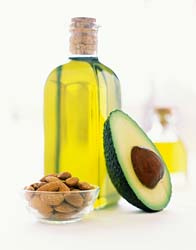Breaking Down Fat

Fat: good or bad? Often blamed for weight-gain and other health issues, the truth is most fat won’t make you fat.
In fact, our bodies need fat to fuel our minds and keep us thinking clearly. It also gives us long-
burning energy and keeps us satiated longer between meals. The trouble is there’s a lot of confusion around fat: where it’s found, why there are so many forms, and the role it plays in one’s health. It’s a lot to think about!
To help you get the best fats in your diet, take a look through this quick guide:
Monounsaturated Fat
Known as the healthy fat, it helps to lower the bad cholesterol (LDL) while increasing the good cholesterol (HDL) aiding in the fight against heart disease. Monounsaturated fats can be found in whole milk products, nuts, like almonds, cashews and walnuts, in addition to avocados, olives, and olive oil. This is why Mediterranean foods have been hailed as one of the most heart-healthy cuisines around.
Polyunsaturated Fat
Polyunsaturated fat is made up of three different fatty acids: Omega-3, Omega-6 and Omega-9. To support a healthy diet, the focus should be on Omega-3 fatty acids, which is best known for its anti-inflammatory properties. Fatty acids also promote healthy skin and the development of our cells, reducing the signs of aging. Look for foods like wild salmon, mackerel and herring, as well as flax and chia seeds.
Saturated Fat
This is a confusing and controversial fat. Saturated fats generally come from animal products in the form of dairy, eggs and meat, but coconut products like oil and butter are also high in saturated fats. In recent years there has been a reversal on the thinking that saturated fats cause heart disease, and a lot more support for foods that might help keep you energized and fuller longer, like butter (specifically grass-fed), coconut oil and eggs.
Trans Fat
The artificial fat. This “bad fat” was created through a process in which liquid oils are hydrogenated in order to withstand processing and provide a longer shelf life. Stay away from this one, which is known for its connection to weight-gain, inflammation and heart disease. Since this fat is found in processed and packaged foods, be on the lookout for partially hydrogenated oils listed in ingredients, a clear indicator trans fats lurk inside.
Keep in mind: while we do need fat in our daily meals, it is high in calories. According to the National Institutes of Health, it’s recommended that fat make up no more than 30% of our total daily calories (this does not include saturated fat; for more information on daily value intake, see the NIH site. Carbohydrates and protein are other common nutrients monitored on labels.) If you eat around 1600 calories a day, you should be getting around 50g of fat. I don’t usually promote calorie counting, but when making changes in one’s diet it is important to be aware of portions and quantities.
How do I like to incorporate healthy fat into my diet? (these percentages all assume a 1600 calorie day)
- When I have oatmeal in the morning I mix in a generous teaspoon of chia seeds, which deliver 3g of fat (6% of the daily value)
- I’ll also mix in a scant tablespoon of butter to my oatmeal, adding 11g of fat (22% of the daily value)
- I love hard boiled eggs as a snack. One egg provides 5g of fat (10% of the daily value)
- Throughout my meals I’ll use extra virgin olive oil, approximating 2 tablespoons, which – at 13g a tablespoon – brings in 26g of fat (52% of the daily value)
- I might have a few walnut halves in the afternoon adding around 5g of fat (10% of daily value)
And that brings me to 50g of fat, which might make up 30% of my daily diet if I’m eating around 1600 calories. I love the benefits good fat adds to my diet, which includes flavor!
Here are some other common sources of fat:
- Half avocado has 21g
- 8oz whole milk has 2.4
- 4oz wild salmon has 7g
- 2 tablespoons peanut butter have 15g
Do note that every diet and body differ so what’s right for you may not be right for the person sitting next to you. Age, gender and lifestyle will all affect the amount of calories you consume on a daily basis as well as how your body will react to and digest nutrients. To better understand just how much fat your diet needs, use the NIH’s daily value as a starting off point and experiment with quantity; you may find that you do better with more fat or you may find you do better with less fat.
Lyfebulb Lyfestyle is here to help you live a richer, fuller life – not a restricted one.
